
by Michel Chossudovsky
from
GlobalResearch Website
Part I
Global Warfare
August 1, 2010
Spanish version
Humanity is at a dangerous crossroads. War preparations to attack Iran are
in "an advanced state of readiness". Hi tech weapons systems including
nuclear warheads are fully deployed.
This military adventure has been on the Pentagon's drawing board since the
mid-1990s. First Iraq, then Iran according to a declassified 1995 US Central
Command document.
Escalation is part of the military agenda. While Iran, is the next target
together with Syria and Lebanon, this strategic military deployment also
threatens North Korea, China and Russia.
Since 2005, the US and its allies, including America's NATO partners and
Israel, have been involved in the extensive deployment and stockpiling of
advanced weapons systems.
The air defense systems of the US, NATO member
countries and Israel are fully integrated.
This is a coordinated endeavor of the Pentagon, NATO, Israel's Defense Force
(IDF), with the active military involvement of several non-NATO partner
countries including the frontline,
...among others.
(NATO consists of
28 NATO member states. Another 21 countries
are members of the
Euro-Atlantic Partnership Council - EAPC -,
The Mediterranean Dialogue and the Istanbul
Cooperation Initiative include ten Arab countries plus Israel.)
The roles of Egypt, the Gulf states and Saudi Arabia (within the extended
military alliance) is of particular relevance.
Egypt controls the transit of war ships and oil
tankers through the Suez Canal. Saudi Arabia and the Gulf States occupy the
South Western coastlines of the Persian Gulf, the Straits of Hormuz and the
Gulf of Oman.
In early June,
"Egypt reportedly allowed one Israeli and
eleven U.S. ships to pass through the Suez Canal in... an apparent
signal to Iran... On June 12, regional press outlets reported that the
Saudis had granted Israel the right to fly over its airspace..."
(Muriel Mirak Weissbach,
Israel's Insane War on Iran Must Be Prevented.,
Global Research, July 31, 2010)
In post 9/11 military doctrine, this massive
deployment of military hardware has been defined as part of the so-called
"Global War on Terrorism", targeting "non-State" terrorist organizations
including al Qaeda and so-called "State sponsors of terrorism", including
Iran, Syria, Lebanon, Sudan.
The setting up of new US military bases, the stockpiling of advanced weapons
systems including tactical nuclear weapons, etc. were implemented as part of
the pre-emptive defensive military doctrine under the umbrella of the Global
"War
on Terrorism".
War and the Economic
Crisis
The broader implications of a US-NATO Israel attack on Iran are
far-reaching.
The war and the economic crisis are intimately
related. The war economy is financed by Wall Street, which stands as the
creditor of the US administration. The US weapons producers are the
recipients of the US Department of Defense multibillion dollar procurement
contracts for advanced weapons systems.
In turn, "the battle for oil" in the Middle East
and Central Asia directly serves the interests of the Anglo-American oil
giants.
The US and its allies are "beating the drums of war" at the height of a
Worldwide economic depression, not to mention the most serious environmental
catastrophe in World history.
In a bitter twist, one of the major players (BP)
on the Middle East Central Asia geopolitical chessboard, formerly known as
the Anglo-Persian Oil Company, is the instigator of the ecological disaster
in the Gulf of Mexico.
Media Disinformation
Public opinion, swayed by media hype is tacitly supportive, indifferent or
ignorant as to the likely impacts of what is upheld as an ad hoc "punitive"
operation directed against Iran's nuclear facilities rather than an all out
war.
War preparations include the deployment of of US
and Israeli produced nuclear weapons. In this context, the devastating
consequences of a nuclear war are either trivialized or simply not
mentioned. The "real crisis" threatening humanity, according to the media
and the governments, is not war but global warming.
The war on Iran is presented to public opinion as an issue among others. It
is not viewed as a threat to "Mother Earth" as in the case of global
warming. It is not front-page news.
The fact that an attack on Iran could lead to
escalation and potentially unleash a "global war" is not a matter of
concern.
The Cult of Killing
and Destruction
The global killing machine is also sustained by an imbedded cult of killing
and destruction which pervades Hollywood movies, not to mention the prime
time war and crime TV series on network television.
This cult of killing is endorsed by the
CIA and the Pentagon which also support (finance) Hollywood productions as
an instrument of war propaganda:
"Ex-CIA agent Bob Baer told us, "There’s a
symbiosis between the CIA and Hollywood" and revealed that former CIA
director George Tenet is currently, "out in Hollywood, talking to
studios."
(Matthew Alford and Robbie Graham,
Lights, Camera… Covert Action: The Deep Politics
of Hollywood, Global Research, January 31, 2009).
The killing machine is deployed at a global
level, within the framework of the unified combat command structure.
It is routinely upheld by the institutions of
government, the corporate media and the mandarins and intellectuals of the
New World Order in Washington's think tanks and strategic studies research
institutes, as an unquestioned instrument of peace and global prosperity.
A culture of killing and violence has become imbedded in human
consciousness.
War is broadly accepted as part of a societal process:
The Homeland needs to be "defended" and
protected.
"Legitimized violence" and extrajudicial
killings directed against "terrorists" are upheld in western democracies, as
necessary instruments of national security.
A "humanitarian war" is upheld by the so-called international community. It
is not condemned as a criminal act. Its main architects are rewarded for
their contributions to world peace.
With regard to Iran, what is unfolding is the outright legitimization of war
in the name of an illusive notion of global security.
A "Pre-emptive" Aerial
attack directed against Iran would lead to Escalation
At present there are three separate Middle East Central Asia war theaters:
Were Iran to be the object of a "pre-emptive" aerial attack by allied
forces, the entire region, from the Eastern Mediterranean to China's Western
frontier with Afghanistan and Pakistan, would flare up, leading us
potentially into a World War III scenario.
The war would also extend into Lebanon and Syria.
It is highly unlikely that the bombings, if they were to be implemented,
would be circumscribed to Iran's nuclear facilities as claimed by US-NATO
official statements.
What is more probable is an all out air attack
on both military and civilian infrastructure, transport systems, factories,
public buildings.
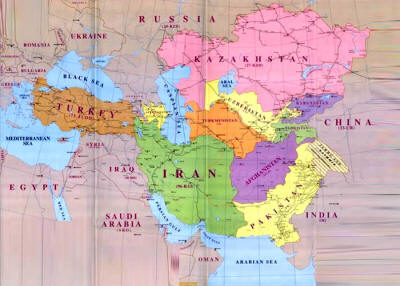
Iran, with an an estimated ten percent of global
oil and gas reserves, ranks third after Saudi Arabia (25 %) and Iraq (11 %)
in the size of its reserves. In comparison, the US possesses less than 2.8 %
of global oil reserves. (See Eric
Waddell,
The Battle for Oil, Global Research,
December 2004).
Of significance is the recent discovery in Iran
of the second largest known reserves of natural gas at Soumar and Halgan
estimated at 12.4 trillion cubic feet.
Targeting Iran consists not only in reclaiming Anglo-American control over
Iran's oil and gas economy, including pipeline routes, it also challenges
the presence and influence of China and Russia in the region.
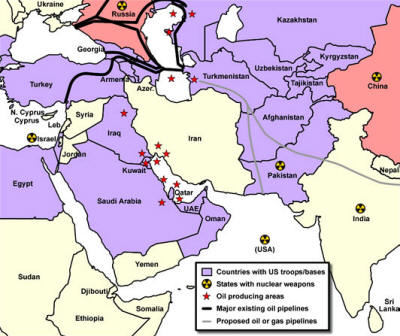
The planned attack on Iran is part of a
coordinated global military road map.
It is part of the Pentagon's "long war", a
profit driven war without borders, a project of World domination, a sequence
of military operations.
US-NATO military planners have envisaged various scenarios of military
escalation. They are also acutely aware of the geopolitical implications,
namely that the war could extend beyond the Middle East Central Asia region.
The economic impacts on the oil markets, etc. have also been analyzed.
While Iran, Syria and Lebanon are the immediate targets, China, Russia,
North Korea, not to mention Venezuela and Cuba are also the object of US
threats.
At stake is the structure of military alliances. US-NATO-Israel military
deployments including military exercises and drills conducted on Russia and
China's immediate borders bear a direct relationship to the proposed war on
Iran.
These veiled threats, including their timing,
constitute an obvious hint to the former powers of the Cold War era not to
intervene in any way which could encroach upon a US-led attack on Iran.
Global Warfare
The medium term strategic objective is to target Iran and neutralize Iran's
allies, through gunboat diplomacy. The longer term military objective is to
directly target China and Russia.
While Iran is the immediate target, military deployment is by no means
limited to the Middle East and Central Asia. A global military agenda has
been formulated.
The deployment of coalition troops and advanced weapons systems by the US,
NATO and its partners is occurring simultaneously in all major regions of
the World.
The recent actions of the US military off the coast of North Korea including
the conduct of war games are part of a global design.
Directed primarily against Russia and China, US, NATO and allied military
exercises, war drills, weapons deployments, etc. are being conducted
simultaneously in major geopolitical hotspots.
-
The Korean Peninsula, the Sea of Japan,
the Taiwan Straits, the South China Sea threatening China
-
The deployment of Patriot missiles in
Poland, the early warning center in the Czech republic threatening
Russia
-
Naval deployments in Bulgaria, Romania
on the Black sea, threatening Russia
-
US and NATO troops deployments in
Georgia
-
A formidable naval deployment in the
Persian Gulf including Israeli submarines directed against Iran.
Concurrently the Eastern Mediterranean, the
Black Sea, the Caribbean, Central America and the Andean region of South
America are areas of ongoing militarization.
In Latin America and the Caribbean, the threats
are directed against Venezuela and Cuba.
US "Military Aid"
In turn, large scale weapons transfers have been undertaken under the banner
of US "military aid" to selected countries, including a 5 billion dollar
arms deal with India which is intended to build India's capabilities
directed against China.
(Huge
U.S.-India Arms Deal To Contain China, Global Times, July 13,
2010).
"[The] arms sales will improve ties between
Washington and New Delhi, and, intentionally or not, will have the
effect of containing China’s influence in the region.”
Rick Rozoff,
Confronting both China and Russia: U.S. Risks
Military Clash With China In Yellow Sea, Global Research,
July 16, 2010
The US has military cooperation agreements with
a number of South East Asian countries including Singapore, Vietnam and
Indonesia, involving "military aid" as well as the participation in U.S.-led
war games in the Pacific Rim (July -August 2010).
These agreements are supportive of weapons
deployments directed against The People's Republic of China.
(See Rick Rozoff,
Confronting both China and Russia: U.S. Risks Military
Clash With China In Yellow Sea,
Global Research, July 16, 2010).
Similarly and more directly related to the planned attack on Iran, the US is
arming the Gulf States (Bahrain, Kuwait, Qatar and the United Arab Emirates)
with land-based interceptor missiles, Patriot Advanced Capability-3 and
Terminal High Altitude Area Defense (THAAD) as well as sea-based Standard
Missile-3 interceptors installed on Aegis class warships in the Persian
Gulf.
(See Rick Rozoff,
NATO’s Role In The Military Encirclement Of Iran,
Global Research, February 10, 2010).
The Timetable of
Military Stockpiling and Deployment
What is crucial in regards to US weapons transfers to partner countries and
allies is the actual timing of delivery and deployment.
The launch of a US sponsored military operation
would normally occur once these weapons systems are in place, effectively
deployed with the implementation of personnel training. (e.g. India).
What we are dealing with is a carefully coordinated global military design
controlled by the Pentagon, involving the combined armed forces of more than
forty countries. This global multinational military deployment is by far the
largest display of advanced weapons systems in World history.
In turn, the US and its allies have established new military bases in
different parts of the world.
"The Surface of the Earth is Structured as a
Wide Battlefield".
(See Jules Dufour,
The Worldwide Network of US Military Bases,
Global Research, July 1, 2007).
The Unified Command structure divided up into
geographic Combatant Commands is predicated on a strategy of militarization
at the global level.
"The US Military has bases in 63 countries.
Brand new military bases have been built since September 11, 2001 in
seven countries. In total, there are 255,065 US military personnel
deployed Worldwide."
See Jules Dufour,
The Worldwide Network of US Military Bases,
Global Research, July 1, 2007
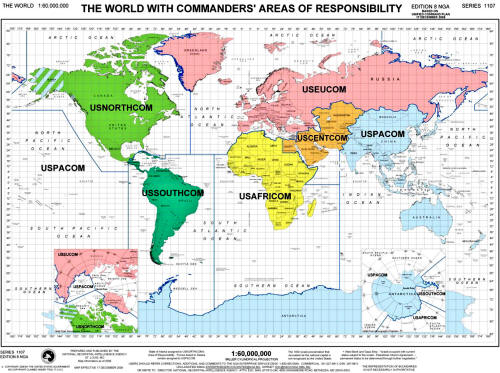
Map-the World With Commander'
Area of Responsibility
Source:
DefenseLINK-Unified Command Plan
World War III Scenario
This military deployment is occurring in several regions simultaneously
under the coordination of the regional US Commands, involving the
stockpiling of US made weapons systems by America's allies, some of which
are former enemies, including Vietnam and Japan.
The present context is characterized by a global military build-up
controlled by one World superpower, which is using its numerous allies to
trigger regional wars.
In contrast to the Second World War was a conjunction of separate regional
war theaters. Given the communications technologies and weapons systems of
the 1940s, there was no strategic "real time" coordination in military
actions between broad geographic regions
Global warfare is based on the coordinated deployment of a single dominant
military power, which oversees the actions of its allies and partners.
With the exception of Hiroshima and Nagasaki, the Second World War was
characterized by the use of conventional weapons. The planning of a global
war relies on the militarization of outer space.
Were a war directed against Iran to be launched,
it would not only use nuclear weapons, the entire gamut of new advanced
weapons systems, including electrometric weapons and
environmental
modification techniques (ENMOD) would be used.
The United Nations
Security Council
The United
Nations Security Council adopted in early June a fourth round of sweeping
sanctions against The Islamic Republic of Iran, which included an expanded
arms embargo as well "tougher financial controls".
In a bitter irony, this resolution was passed
within days of the United Nations Security Council's outright refusal to
adopt a motion condemning Israel for its attack on the Gaza Freedom Flotilla
in international waters.
Both China and Russia, pressured by the US, have endorsed the UNSC
sanctions' regime, to their own detriment.
Their decision within the UNSC contributes to
weakening their own military alliance, the Shanghai Cooperation
Organization (SCO), in which Iran has observer status. The Security
Council resolution freezes China and Russia's respective bilateral military
cooperation and trade agreements with Iran. It has serious repercussions on
Iran's air defense system which in part depends on Russian technology and
expertise.
The Security Council resolution grants a de facto "green light" to wage a
pre-emptive war against Iran.
The American
Inquisition - Building a Political Consensus for War
In chorus, the Western media has branded Iran as a threat to global security
in view of its alleged (non-existent) nuclear weapons program. Echoing
official statements, the media is now demanding the implementation of
punitive bombings directed against Iran so as to safeguard Israel's
security.
The Western media is beating the drums of war. The purpose is to tacitly
instill, through repeated media reports, ad nauseam, within people's inner
consciousness, the notion that the Iranian threat is real and that the
Islamic Republic should be "taken out".
A consensus building process to wage war is similar to the Spanish
inquisition. It requires and demands submission to the notion that war is a
humanitarian endeavor.
Known and documented, the real threat to global security emanates from the
US-NATO-Israel alliance, yet realities in an inquisitorial environment are
turned upside down:
the warmongers are committed to peace, the
victims of war are presented as the protagonists of war.
Whereas in 2006, almost two thirds of Americans
were opposed to military action against Iran, a recent Reuter-Zogby February
2010 poll suggests that 56 % of Americans favor a US-NATO military action
against Iran.
Building a political consensus which is based on an outright lie cannot,
however, rely solely on the official position of those who are the source of
the lie.
The antiwar movement in the US, which has in part been infiltrated and
co-opted, has taken on a weak stance with regard to Iran. The antiwar
movement is divided. The emphasis has been on wars which have already
occurred (Afghanistan, Iraq) rather than forcefully opposing wars which are
being prepared and which are currently on the Pentagon's drawing board.
Since the inauguration of the
Obama
administration, the antiwar movement has lost some of its
impetus.
Moreover, those who actively oppose the wars on Afghanistan and Iraq, do not
necessarily oppose the conduct of "punitive bombings" directed Iran, nor do
they categorize these bombings as an act of war, which could potentially be
a prelude to World War III.
The scale of antiwar protest in relation to Iran has been minimal in
comparison to the mass demonstrations which preceded the 2003 bombing and
invasion of Iraq.
The real threat to global security emanates from the US-NATO-Israel
alliance.
The Iran operation is not being opposed in the diplomatic arena by China and
Russia; it has the support of the governments of the frontline Arab states
which are integrated into the NATO sponsored Mediterranean dialogue. It also
has the tacit support of Western public opinion.
We call upon people across the land, in America, Western Europe, Israel,
Turkey and around the world to rise up against this military project,
against their governments which are supportive of military action against
Iran, against the media which serves to camouflage the devastating
implications of a war against Iran.
The military agenda support a profit driven destructive global economic
system which impoverishes large sectors of the world population.
This war is sheer madness. World War III is terminal.
Albert Einstein understood the perils of
nuclear war and the extinction of life on earth, which has already started
with the radioactive contamination resulting from
depleted uranium.
“I know not with what weapons World War III
will be fought, but World War IV will be fought with sticks and stones.”
The media, the intellectuals, the scientists and
the politicians, in chorus, obfuscate the untold truth, namely that war
using nuclear warheads destroys humanity, and that this complex process of
gradual destruction has already commenced.
When the lie becomes the truth there is no turning backwards.
When war is upheld as a humanitarian endeavor, Justice and the entire
international legal system are turned upside down: pacifism and the antiwar
movement are criminalized. Opposing the war becomes a criminal act.
The Lie must be exposed for what it is and what it does.
-
It sanctions the indiscriminate killing
of men, women and children.
-
It destroys families and people. It
destroys the commitment of people towards their fellow human beings.
-
It prevents people from expressing their
solidarity for those who suffer. It upholds war and the police state
as the sole avenue.
-
It destroys internationalism.
Breaking the lie means breaking a criminal
project of global destruction, in which the quest for profit is the
overriding force.
This profit driven military agenda destroys human values and transforms
people into unconscious zombies.
-
Let us reverse the tide.
-
Challenge the war criminals in high
office.
-
Break the American inquisition.
-
Undermine the US-NATO-Israel military
crusade.
-
Close down the weapons factories and the
military bases.
-
Bring home the troops.
Members of the armed forces should disobey
orders and refuse to participate in a criminal war.
Part II
The Military Road Map
August 13, 2010
Spanish version
The stockpiling and deployment of advanced weapons systems directed against
Iran started in the immediate wake of the 2003 bombing and invasion of Iraq.
From the outset, these war plans were led by the US, in liaison with NATO
and Israel.
Following the 2003 invasion of Iraq, the
Bush administration identified Iran
and Syria as the next stage of “the road map to war”.
US military sources intimated that an aerial
attack on Iran could involve a large scale deployment comparable to the US
"shock and awe" bombing raids on Iraq in March 2003:
"American air strikes on Iran would vastly
exceed the scope of the 1981 Israeli attack on the Osiraq nuclear center
in Iraq, and would more resemble the opening days of the 2003 air
campaign against Iraq.
(See
Globalsecurity)
"Theater Iran Near Term"
Code named by US military planners as TIRANNT, "Theater Iran Near Term",
simulations of an attack on Iran were initiated in May 2003,
"when modelers
and intelligence specialists pulled together the data needed for
theater-level (meaning large-scale) scenario analysis for Iran."
(William Arkin, Washington Post, 16 April 2006).
The scenarios identified several thousand targets inside Iran as part of a
"Shock and Awe" Blitzkrieg:
"The analysis, called TIRANNT, for "Theater
Iran Near Term," was coupled with a mock scenario for a Marine Corps
invasion and a simulation of the Iranian missile force. U.S. and British
planners conducted a Caspian Sea war game around the same time. And Bush
directed the U.S. Strategic Command to draw up a global strike war plan
for an attack against Iranian weapons of mass destruction.
All of this
will ultimately feed into a new war plan for "major combat operations"
against Iran that military sources confirm now [April 2006] exists in
draft form.
... Under TIRANNT, Army and U.S. Central Command planners have been
examining both near-term and out-year scenarios for war with Iran,
including all aspects of a major combat operation, from mobilization and
deployment of forces through postwar stability operations after regime
change."
(William Arkin, Washington Post, 16 April
2006)
Different "theater scenarios" for an all out
attack on Iran had been contemplated:
"The US army, navy, air force and marines
have all prepared battle plans and spent four years building bases and
training for "Operation Iranian Freedom". Admiral Fallon, the new head
of US Central Command, has inherited computerized plans under the name
TIRANNT (Theatre Iran Near Term)."
(New Statesman, February 19, 2007)
In 2004, drawing upon the initial war scenarios
under TIRANNT, Vice President Dick Cheney instructed USSTRATCOM to draw up a
"contingency plan" of a large scale military operation directed against Iran
"to be employed in response to another 9/11-type terrorist attack on the
United States" on the presumption that the government in Tehran would be
behind the terrorist plot.
The plan included the pre-emptive use of nuclear
weapons against a non-nuclear state:
"The plan includes a large-scale air assault
on Iran employing both conventional and tactical nuclear weapons. Within
Iran there are more than 450 major strategic targets, including numerous
suspected nuclear-weapons-program development sites. Many of the targets
are hardened or are deep underground and could not be taken out by
conventional weapons, hence the nuclear option.
As in the case of Iraq, the response is not
conditional on Iran actually being involved in the act of terrorism
directed against the United States. Several senior Air Force officers
involved in the planning are reportedly appalled at the implications of
what they are doing - that Iran is being set up for an unprovoked
nuclear attack - but no one is prepared to damage his career by posing
any objections."
(Philip Giraldi,
Deep Background, The
American Conservative August 2005)
The Military Road Map
- "First Iraq, then Iran"
The decision to target Iran under TIRANNT was part of the broader process of
military planning and sequencing of military operations. Already under the
Clinton administration, US Central Command (USCENTCOM) had formulated "in
war theater plans" to invade first Iraq and then Iran.
Access to Middle East oil was the stated
strategic objective:
"The broad national security interests and
objectives expressed in the President's National Security Strategy (NSS)
and the Chairman's National Military Strategy (NMS) form the foundation
of the United States Central Command's theater strategy. The NSS directs
implementation of a strategy of dual containment of the rogue states of
Iraq and Iran as long as those states pose a threat to U.S. interests,
to other states in the region, and to their own citizens.
Dual containment is designed to maintain the
balance of power in the region without depending on either Iraq or Iran.
USCENTCOM's theater strategy is interest-based and threat-focused. The
purpose of U.S. engagement, as espoused in the NSS, is to protect the
United States' vital interest in the region - uninterrupted, secure
U.S./Allied access to Gulf oil."
(USCENTCOM,
http://www.milnet.com/milnet/pentagon/centcom/chap1/stratgic.htm#USPolicy,
link no longer active, archived at
http://tinyurl.com/37gafu9)
The war on Iran was viewed as part of a
succession of military operations.
According to (former) NATO Commander General
Wesley Clark, the Pentagon's military road-map consisted of a sequence of
countries:
"[The] Five-year campaign plan [includes]...
a total of seven countries, beginning with Iraq, then Syria, Lebanon,
Libya, Iran, Somalia and Sudan." In "Winning Modern Wars"
(page 130)
General Clark states the following:
"As I went back through the Pentagon in
November 2001, one of the senior military staff officers had time for a
chat. Yes, we were still on track for going against Iraq, he said. But
there was more. This was being discussed as part of a five-year campaign
plan, he said, and there were a total of seven countries, beginning with
Iraq, then Syria, Lebanon, Libya, Iran, Somalia and Sudan.
(See
Secret 2001 Pentagon Plan to Attack
Lebanon, Global Research, July 23, 2006)
The Role of Israel
There has been much debate regarding the role of Israel in initiating an
attack against Iran.
Israel is part of a military alliance. Tel Aviv is not a prime mover. It
does not have a separate and distinct military agenda.
Israel is integrated into the "war plan for major combat operations" against
Iran formulated in 2006 by US Strategic Command (USSTRATCOM). In the context
of large scale military operations, an uncoordinated unilateral military
action by one coalition partner, namely Israel, is from a military and
strategic point almost an impossibility. Israel is a de facto member of
NATO.
Any action by Israel would require a "green light" from Washington.
An attack by Israel could, however, be used as "the trigger mechanism" which
would unleash an all out war against Iran, as well retaliation by Iran
directed against Israel.
In this regard, there are indications that Washington might envisage the
option of an initial (US backed) attack by Israel rather than an outright
US-led military operation directed against Iran. The Israeli attack
--although led in close liaison with the Pentagon and NATO-- would be
presented to public opinion as a unilateral decision by Tel Aviv.
It would then be used by Washington to justify,
in the eyes of World opinion, a military intervention of the US and NATO
with a view to "defending Israel", rather than attacking Iran.
Under existing military cooperation agreements,
both the US and NATO would be "obligated" to "defend Israel" against Iran
and Syria.
It is worth noting, in this regard, that at the outset of Bush's second
term, (former) Vice President Dick Cheney hinted, in no uncertain terms,
that Iran was,
"right at the top of the list" of the "rogue
enemies" of America, and that Israel would, so to speak, "be doing the
bombing for us", without US military involvement and without us putting
pressure on them "to do it"
(See Michel Chossudovsky,
Planned
US-Israeli Attack on Iran, Global Research, May 1, 2005)
According to Cheney:
"One of the concerns people have is that
Israel might do it without being asked... Given the fact that Iran has a
stated policy that their objective is the destruction of Israel, the
Israelis might well decide to act first, and let the rest of the world
worry about cleaning up the diplomatic mess afterwards."
(Dick Cheney, quoted from an MSNBC
Interview, January 2005)
Commenting the Vice President's assertion,
former National Security adviser
Zbigniew Brzezinski in an interview on PBS,
confirmed with some apprehension, yes: Cheney wants Prime Minister Ariel
Sharon to act on America's behalf and "do it" for us:
"Iran I think is more ambiguous. And there
the issue is certainly not tyranny; it's nuclear weapons. And the vice
president today in a kind of a strange parallel statement to this
declaration of freedom hinted that the Israelis may do it and in fact
used language which sounds like a justification or even an encouragement
for the Israelis to do it."
What we are dealing with is a joint
US-NATO-Israel military operation to bomb Iran, which has been in the active
planning stage since 2004.
Officials in the Defense Department, under Bush
and Obama, have been working assiduously with their Israeli military and
intelligence counterparts, carefully identifying targets inside Iran. In
practical military terms, any action by Israel would have to be planned and
coordinated at the highest levels of the US led coalition.
An attack by Israel would also require coordinated US-NATO logistical
support, particularly with regard to Israel's air defense system, which
since January 2009 is fully integrated into that of the US and NATO.
(See Michel Chossudovsky,
Unusually Large
U.S. Weapons Shipment to Israel: Are the US and Israel Planning a Broader
Middle East War? Global Research, January 11,2009)
Israel's X band radar system established in early 2009 with US technical
support has,
"integrate[d] Israel’s missile defenses with
the U.S. global missile [Space-based] detection network, which includes
satellites, Aegis ships on the Mediterranean, Persian Gulf and Red Sea,
and land-based Patriot radars and interceptors."
(Defense Talk.com, January 6, 2009)
What this means is that Washington ultimately
calls the shots. The US rather than Israel controls the air defense system:
'''This is and will remain a U.S. radar
system,' Pentagon spokesman Geoff Morrell said. 'So this is not
something we are giving or selling to the Israelis and it is something
that will likely require U.S. personnel on-site to operate.'"
(Quoted in Israel National News, January
9, 2009).
The US military oversees Israel's Air Defense
system, which is integrated into the Pentagon's global system. In other
words, Israel cannot launch a war against Iran without Washington's consent.
Hence the importance of the so-called "Green
Light" legislation in the US Congress sponsored by the Republican party
under House Resolution 1553, which explicitly supports an Israeli attack on
Iran:
"The measure, introduced by Texas Republican
Louie Gohmert and 46 of his colleagues, endorses Israel’s use of “all
means necessary” against Iran “including the use of military force.” ...
“We’ve got to get this done. We need to show
our support for Israel. We need to quit playing games with this critical
ally in such a difficult area.”’
(See Webster Tarpley,
Fidel Castro Warns
of Imminent Nuclear War; Admiral Mullen Threatens Iran; US-Israel Vs.
Iran-Hezbollah Confrontation Builds On, Global Research, August 10,
2010)
In practice, the proposed legislation is a
"Green Light" to the White House and the Pentagon rather than to Israel. It
constitutes a rubber stamp to a US sponsored war on Iran which uses Israel
as a convenient military launch pad. It also serves as a justification to
wage war with a view to defending Israel.
In this context, Israel could indeed provide the pretext to wage war, in
response to alleged Hamas or Hezbollah attacks and/or the triggering of
hostilities on the border of Israel with Lebanon.
What is crucial to
understand is that a minor "incident" could be used as a pretext to spark
off a major military operation against Iran.
Known to US military planners, Israel (rather than the USA) would be the
first target of military retaliation by Iran. Broadly speaking, Israelis
would be the victims of the machinations of both Washington and their own
government.
It is, in this regard, absolutely crucial that
Israelis forcefully oppose any action by the Netanyahu government to attack
Iran.
Global Warfare - The
Role of US Strategic Command (USSTRATCOM)
Global military operations are coordinated out of US Strategic Command
Headquarters (USSTRATCOM) at the Offutt Air Force base in Nebraska, in
liaison with the regional commands of the unified combatant commands (e.g..
US Central Command in Florida, which is responsible for the Middle
East-Central Asian region, See map below) as well as coalition command units
in Israel, Turkey, the Persian Gulf and the Diego Garcia military base in
the Indian Ocean.
Military planning and decision making at a
country level by individual allies of US-NATO as well as "partner nations"
is integrated into a global military design including the weaponization of
space.
Under its new mandate, USSTRATCOM has a responsibility for "overseeing a
global strike plan" consisting of both conventional and nuclear weapons.
In
military jargon, it is slated to play the role of,
"a global integrator charged with the
missions of Space Operations; Information Operations; Integrated Missile
Defense; Global Command & Control; Intelligence, Surveillance and
Reconnaissance; Global Strike; and Strategic Deterrence..."
USSTRATCOM's responsibilities include:
"leading, planning, & executing strategic
deterrence operations" at a global level, "synchronizing global missile
defense plans and operations", "synchronizing regional combat plans",
etc.
USSTRATCOM is the lead agency in the
coordination of modern warfare.
In January 2005, at the outset of the military deployment and build-up
directed against Iran, USSTRATCOM was identified as,
"the lead Combatant Command for integration
and synchronization of DoD-wide efforts in combating weapons of mass
destruction."
(Michel Chossudovsky,
Nuclear War against
Iran, Global Research, January 3, 2006).
What this means is that the coordination of a
large scale attack on Iran, including the various scenarios of escalation in
and beyond the broader Middle East Central Asian region would be coordinated
by USSTRATCOM.
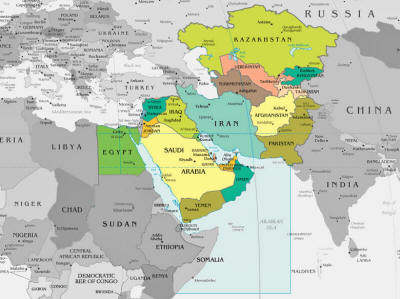
Map
US Central Command's Area of
Jurisdiction
Tactical Nuclear
Weapons directed against Iran
Confirmed by military documents as well as official statements, both the US
and Israel contemplate the use of nuclear weapons directed against Iran.
In 2006, U.S. Strategic Command (USSTRATCOM)
announced it had achieved an operational capability for rapidly striking
targets around the globe using nuclear or conventional weapons. This
announcement was made after the conduct of military simulations
pertaining to a US led nuclear attack against a fictional country.
(David Ruppe,
Preemptive Nuclear War in a
State of Readiness: U.S. Command Declares Global Strike Capability,
Global Security Newswire, December 2, 2005)
Continuity in relation to the Bush-Cheney era:
President Obama has
largely endorsed the doctrine of pre-emptive use of nuclear weapons
formulated by the previous administration.
Under the 2010 Nuclear Posture Review, the
Obama administration confirmed,
"that it is reserving the right to use
nuclear weapons against Iran" for its non-compliance with US demands
regarding its alleged (nonexistent) nuclear weapons program.
(U.S. Nuclear Option on Iran Linked to
Israeli Attack Threat - IPS ipsnews.net, April 23, 2010).
The Obama administration has also intimated
that it would use nukes in the case of an Iranian response to an Israeli
attack on Iran.
(Ibid).
Israel has also drawn up its own "secret plans"
to bomb Iran with tactical nuclear weapons:
"Israeli military commanders believe
conventional strikes may no longer be enough to annihilate increasingly
well-defended enrichment facilities. Several have been built beneath at
least 70ft of concrete and rock. However, the nuclear-tipped
bunker-busters would be used only if a conventional attack was ruled out
and if the United States declined to intervene, senior sources said."
(Revealed: Israel plans nuclear strike on
Iran - Times Online, January 7, 2007)
Obama's statements on the use of nuclear weapons
against Iran and North Korea are consistent with post 9/11 US nuclear
weapons doctrine, which allows for the use of tactical nuclear weapons in
the conventional war theater.
Through a propaganda campaign which has enlisted the support of
"authoritative" nuclear scientists, mini-nukes are upheld as an instrument
of peace, namely a means to combating "Islamic terrorism" and instating
Western style "democracy" in Iran. The low-yield nukes have been cleared for
"battlefield use".
They are slated to be used against Iran and
Syria in the next stage of America's "war on Terrorism" alongside
conventional weapons.
"Administration officials argue that
low-yield nuclear weapons are needed as a credible deterrent against
rogue states. [Iran, Syria, North Korea] Their logic is that existing
nuclear weapons are too destructive to be used except in a full-scale
nuclear war.
Potential enemies realize this, thus they do not consider
the threat of nuclear retaliation to be credible. However, low-yield
nuclear weapons are less destructive, thus might conceivably be used.
That would make them more effective as a deterrent."
(Opponents Surprised By Elimination of
Nuke Research Funds Defense News November 29, 2004)
The preferred nuclear weapon to be used against
Iran are tactical nuclear weapons (Made in America), namely bunker buster
bombs with nuclear warheads (e.g. B61.11), with an explosive capacity
between one third to six times a Hiroshima bomb.
The
B61-11 is the "nuclear version" of the
"conventional" BLU 113 or Guided Bomb Unit GBU-28. It can be delivered in
much same way as the conventional bunker buster bomb.
(See Michel Chossudovsky,
http://www.globalresearch.ca/articles/CHO112C.html,
see also
http://www.thebulletin.org/article_nn.php?art_ofn=jf03norris).
While the US does not contemplate the use of
strategic thermonuclear weapons against Iran, Israel's nuclear arsenal is
largely composed of thermonuclear bombs which are deployed and could be used
in a war with Iran.
Under Israel's Jericho-III missile system with a
range between 4,800 km to 6,500 km, all Iran would be within reach.

Conventional bunker buster
Guided Bomb Unit GBU-27
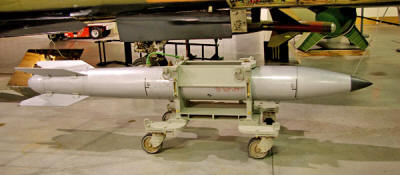
B61 bunker buster bomb
Radioactive Fallout
The issue of radioactive fallout and contamination, while casually dismissed
by US-NATO military analysts, would be devastating, potentially affecting a
large area of the broader Middle East (including Israel) and Central Asian
region.
In an utterly twisted logic, nuclear weapons are presented as a means to
building peace and preventing "collateral damage".
Iran's nonexistent
nuclear weapons are a threat to global security, whereas those of the US and
Israel are instruments of peace "harmless to the surrounding civilian
population".
"The Mother of All
Bombs" (MOAB) Slated to be Used against Iran
Of military significance within the US conventional weapons arsenal is the
21,500-pound "monster weapon" nicknamed the "mother of all bombs".
The GBU-43/B or Massive Ordnance Air Blast bomb
(MOAB) was categorized "as the most powerful non-nuclear weapon ever
designed" with the the largest yield in the US conventional arsenal.
The
MOAB was tested in early March 2003 before being deployed to the Iraq war
theater.
According to US military sources, The Joint
Chiefs of Staff had advised the government of Saddam Hussein prior to
launching the 2003 that the "mother of all bombs" was to be used against
Iraq. (There were unconfirmed reports that it had been used in Iraq).
The US Department of Defense has confirmed in October 2009 that it intends
to use the "Mother of All Bombs" (MOAB) against Iran.
The MOAB is said to be,
"ideally suited to hit deeply buried nuclear facilities such as Natanz or
Qom in Iran".
(Jonathan Karl,
Is the U.S. Preparing to Bomb Iran? ABC News,
October 9, 2009).
The truth of the matter is that the MOAB, given its
explosive capacity, would result in extremely large civilian casualties.
It is a conventional "killing machine" with a
nuclear type mushroom cloud.
The procurement of four MOABs was commissioned in October 2009 at the hefty
cost of $58.4 million, ($14.6 million for each bomb). This amount includes
the costs of development and testing as well as integration of the MOAB
bombs onto B-2 stealth bombers. (Ibid). This procurement is directly linked
to war preparations in relation to Iran.
The notification was contained in a 93-page
"reprogramming memo" which included the following instructions:
"The Department has an Urgent Operational
Need (UON) for the capability to strike hard and deeply buried targets
in high threat environments. The MOP [Mother of All Bombs] is the weapon
of choice to meet the requirements of the UON [Urgent Operational
Need]."
It further states that the request is endorsed by Pacific
Command (which has responsibility over North Korea) and Central Command
(which has responsibility over Iran)."
(ABC News, op cit).
To consult the reprogramming request
click
here.
The Pentagon is planning on a process of extensive destruction of Iran's
infrastructure and mass civilian casualties through the combined use of
tactical nukes and monster conventional mushroom cloud bombs, including the
MOAB and the larger GBU-57A/B or Massive Ordnance Penetrator (MOP), which
surpasses the MOAB in terms of explosive capacity.
The MOP is described as,
"a powerful new bomb aimed squarely at the
underground nuclear facilities of Iran and North Korea. The gargantuan
bomb - longer than 11 persons standing shoulder-to-shoulder [see image
below] or more than 20 feet base to nose".
(See Edwin Black, "Super Bunker-Buster
Bombs Fast-Tracked for Possible Use Against Iran and North Korea Nuclear
Programs", Cutting Edge, September 21 2009)
These are WMDs in the true sense of the word.
The not so hidden objective of the MOAB and MOP,
including the American nickname used to casually describe the MOAB ("mother
of all bombs'), is "mass destruction" and mass civilian casualties with a
view to instilling fear and despair.
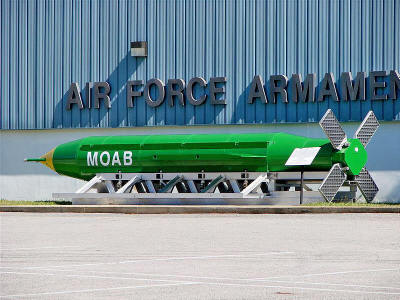
"Mother of All Bombs" (MOAB)
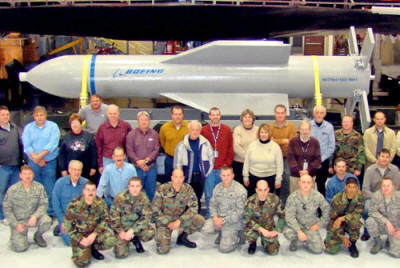
GBU-57A/B Mass Ordnance Penetrator (MOP)
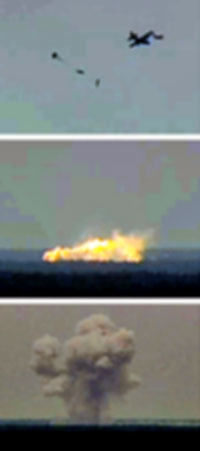
MOAB
screen shots of test: explosion and mushroom cloud
State of the Art
Weaponry - "War Made Possible Through New Technologies"
The process of US military decision making in relation to Iran is supported
by Star Wars, the militarization of outer space and the revolution in
communications and information systems.
Given the advances in military technology and
the development of new weapons systems, an attack on Iran could be
significantly different in terms of the mix of weapons systems, when
compared to the March 2003 Blitzkrieg launched against Iraq. The Iran
operation is slated to use the most advanced weapons systems in support of
its aerial attacks. In all likelihood, new weapons systems will be tested.
The 2000 Project of the New American Century (PNAC) document entitled
Rebuilding America's Defenses, outlined the mandate of the US military in
terms of large scale theater wars, to be waged simultaneously in different
regions of the World:
"Fight and decisively win multiple,
simultaneous major theater wars".
This formulation is tantamount to a global war
of conquest by a single imperial superpower.
The PNAC document also called for the
transformation of U.S. forces to exploit the,
“revolution in military
affairs", namely the implementation of "war made possible through new
technologies".
(See
Project for a New American Century).
The latter consists in developing and perfecting
a state of the art global killing machine based on an arsenal of
sophisticated new weaponry, which would eventually replace the existing
paradigms.
"Thus, it can be foreseen that the process
of transformation will in fact be a two-stage process: first of
transition, then of more thoroughgoing transformation. The breakpoint
will come when a preponderance of new weapons systems begins to enter
service, perhaps when, for example, unmanned aerial vehicles begin to be
as numerous as manned aircraft.
In this regard, the Pentagon should be
very wary of making large investments in new programs – tanks, planes,
aircraft carriers, for example – that would commit U.S. forces to
current paradigms of warfare for many decades to come.
(Ibid)
The war on Iran could indeed mark this crucial
breakpoint, with new space-based weapons systems being applied with a view
to disabling an enemy which has significant conventional military
capabilities including more than half a million ground forces.
Electromagnetic
Weapons
Electromagnetic weapons could be used to destabilize Iran's communications
systems, disable electric power generation, undermine and destabilize
command and control, government infrastructure, transportation, energy, etc.
Within the same family of weapons, environmental
modifications techniques (ENMOD) (weather warfare) developed under the
HAARP
program could also be applied. (See
Michel Chossudovsky, "Owning the Weather for Military Use", Global Research,
September 27, 2004).
These weapons systems are fully operational. In
this context, te US Air Force document AF 2025 explicitly acknowledged the
military applications of weather modification technologies:
"Weather modification will become a part of
domestic and international security and could be done unilaterally... It
could have offensive and defensive applications and even be used for
deterrence purposes.
The ability to generate precipitation, fog,
and storms on earth or to modify space weather, improve communications
through ionospheric modification (the use of ionospheric mirrors), and
the production of artificial weather all are a part of an integrated set
of technologies which can provide substantial increase in US, or
degraded capability in an adversary, to achieve global awareness, reach,
and power."
(Air Force 2025).
Electromagnetic radiation enabling "remote
health impairment" might also be envisaged in the war theater.
(See Mojmir Babacek,
Electromagnetic and Informational Weapons, Global
Research, August 6, 2004).
In turn, new uses of biological weapons by the
US military might also be envisaged as suggested by the PNAC:
"[A]dvanced forms of biological warfare that
can “target” specific genotypes may transform biological warfare from
the realm of terror to a politically useful tool."
(PNAC, op cit., p. 60).
Iran's Military
Capabilities - Medium and Long Range Missiles
Iran has advanced military capabilities, including medium and long range
missiles capable of reaching targets in Israel and the Gulf States.
Hence the emphasis by the US-NATO Israel
alliance on the use of nuclear weapons, which are slated to be used either
preemptively or in response to an Iranian retaliatory missile attack.
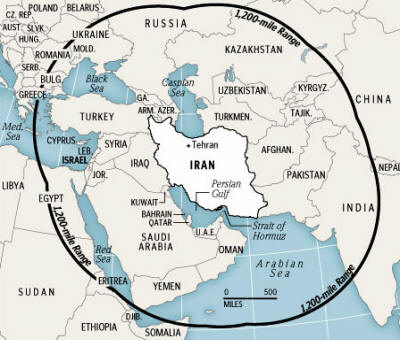
Range of Iran's Shahab
Missiles
In November 2006, Iran tests of surface missiles
2 were marked by precise planning in a carefully staged operation.
According
to a senior American missile expert (quoted by Debka),
"the Iranians demonstrated up-to-date
missile-launching technology which the West had not known them to
possess."
(See Michel Chossudovsky,
Iran's "Power of Deterrence"
Global
Research, November 5, 2006)
Israel acknowledged that,
"the Shehab-3,
whose 2,000-km range brings Israel, the Middle East and Europe within
reach"
(Debka, November 5, 2006)
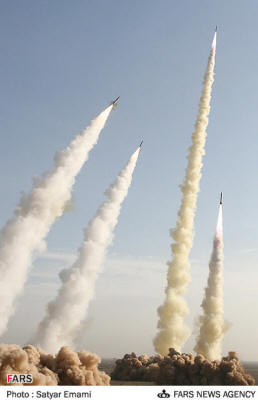
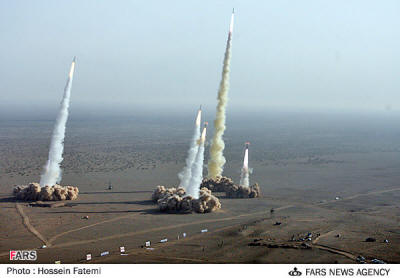
According to Uzi Rubin, former head of Israel's
anti-ballistic missile program,
"the intensity of the military exercise was
unprecedented... It was meant to make an impression - and it made an
impression."
(www.cnsnews.com - 3 November 2006)
The 2006 exercises, while creating a political
stir in the US and Israel, did not in any way modify US-NATO-Israeli resolve
to wage on Iran.
Tehran has confirmed in several statements that it will respond if it is
attacked. Israel would be the immediate object of Iranian missile attacks as
confirmed by the Iranian government.
The issue of Israel's air defense system is
therefore crucial. US and allied military facilities in the Gulf states,
Turkey, Saudi Arabia, Afghanistan and Iraq could also be targeted by Iran.
Iran's Ground Forces
While Iran is encircled by US and allied military bases, the Islamic
Republic has significant military capabilities. (See maps below) What is
important to acknowledge is the sheer size of Iranian forces in terms of
personnel (army, navy, air force) when compared to US and NATO forces
serving in Afghanistan and Iraq.
Confronted with a well organized insurgency, coalition forces are already
overstretched in both Afghanistan and Iraq. Would these forces be able to
cope if Iranian ground forces were to enter the existing battlefield in Iraq
and Afghanistan? The potential of the Resistance movement to US and allied
occupation would inevitably be affected.
Iranian ground forces are of,
the order of 700,000 of which 130,000 are
professional soldiers, 220,000 are conscripts and 350,000 are reservists.
(See
Islamic Republic of Iran Army - Wikipedia).
There are 18,000 personnel
in Iran's Navy and 52,000 in the air force.
According to the International
Institute for Strategic Studies,
"the Revolutionary Guards has an estimated
125,000 personnel in five branches: Its own Navy, Air Force, and Ground
Forces; and the Quds Force (Special Forces)."
According to the CISS, Iran's
Basij paramilitary volunteer force controlled by the Revolutionary Guards,
"has an estimated 90,000 active-duty full-time uniformed members, 300,000
reservists, and a total of 11 million men that can be mobilized if need be".
(Armed Forces of the Islamic Republic of Iran - Wikipedia)
In other words,
Iran can mobilize up to half a million regular troops and several million
militia. Its Quds special forces are already operating inside Iraq.
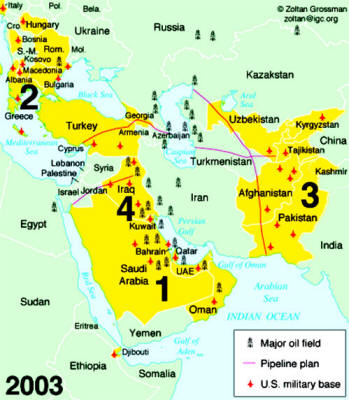
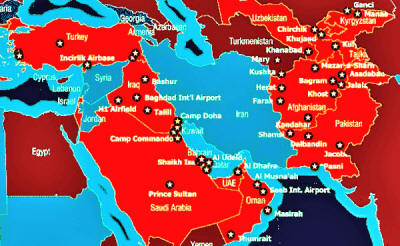
US Military and Allied
Facilities Surrounding Iran
For several years now Iran has been conducting its own war drills and
exercises.
While its Air force has weaknesses, its intermediate and
long-range missiles are fully operational. Iran's military is in a state of
readiness. Iranian troop concentrations are currently within a few
kilometers of the Iraqi and Afghan borders, and within proximity of Kuwait.
The Iranian Navy is deployed in the Persian Gulf within proximity of US and
allied military facilities in the United Arab Emirates.
It is worth noting that in response to Iran's military build-up, the US has
been transferring large amounts of weapons to its non-NATO allies in the
Persian Gulf including Kuwait and Saudi Arabia.
While Iran's advanced weapons do not measure up to those of the US and NATO,
Iranian forces would be in a position to inflict substantial losses to
coalition forces in a conventional war theater, on the ground in Iraq or
Afghanistan. Iranian ground troops and tanks in December 2009 crossed the
border into Iraq without being confronted or challenged by allied forces and
occupied a disputed territory in the East Maysan oil field.
Even in the event of an effective Blitzkrieg, which targets Iran's military
facilities, its communications systems, etc. through massive aerial bombing,
using cruise missiles, conventional bunker buster bombs and tactical nuclear
weapons, a war with Iran, once initiated, could eventually lead into a
ground war.
This is something which US military planners have no doubt
contemplated in their simulated war scenarios.
-
An operation of this nature would result in significant military and
civilian casualties, particularly if nuclear weapons are used.
-
The expanded budget for the war in Afghanistan currently debated in the US
Congress is also intended to be used in the eventuality of an attack on
Iran.
-
Within a scenario of escalation, Iranian troops could cross the border into
Iraq and Afghanistan.
-
In turn, military escalation using nuclear weapons could lead us into a
World War III scenario, extending beyond the Middle East Central Asian
region.
-
In a very real sense, this military project, which has been on the
Pentagon's drawing board for more than five years, threatens the future of
humanity.
Our focus in this essay has been on war preparations.
The fact that war
preparations are in an advanced state of readiness does not imply that these
war plans will be carried out.
The US-NATO-Israel alliance realizes that the enemy has significant
capabilities to respond and retaliate. This factor in itself has been
crucial over the last five years in the decision by the US and its allies to
postpone an attack on Iran.
Another crucial factor is the structure of military alliances. Whereas NATO
has become a formidable force, the Shanghai Cooperation Organization (SCO),
which constitutes an alliance between Russia and China and a number of
former Soviet republics has been significantly weakened.
The ongoing US military threats directed against China and Russia are
intended to weaken the SCO and discourage any form of military action on the
part of Iran's allies in the case of a US NATO Israeli attack.
What are the countervailing forces which might prevent this war from
occurring? There are numerous ongoing forces at work within the US State
apparatus:
-
the US Congress
-
the Pentagon
-
NATO
The central force in preventing a war from occurring ultimately comes from
the base of society, requiring forceful antiwar action by hundred of
millions of people across the land, nationally and internationally.
People must mobilize not only against this diabolical military agenda, the
authority of the State and its officials must be also be challenged.
This war can be prevented if people forcefully confront their governments,
pressure their elected representatives, organize at the local level in
towns, villages and municipalities, spread the word, inform their fellow
citizens as to the implications of a nuclear war, initiate debate and
discussion within the armed forces.
The holding of mass demonstrations and antiwar protests is not enough. What
is required is the development of a broad and well organized grassroots
antiwar network which challenges the structures of power and authority.
What is required is a mass movement of people which forcefully challenges
the legitimacy of war, a global people's movement which criminalizes war.














